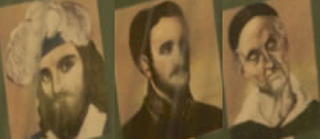William Gibson was a layman from Ripon in Yorkshire, England, a member of a noble Scottish family, who was executed at York for professing the Roman Catholic faith. He is honoured as a martyr by the Catholic Church.

The Forty Martyrs of England and Wales or Cuthbert Mayne and Thirty-Nine Companion Martyrs are a group of Catholic, lay and religious, men and women, executed between 1535 and 1679 for treason and related offences under various laws enacted by Parliament during the English Reformation. The individuals listed range from Carthusian monks who in 1535 declined to accept Henry VIII's Act of Supremacy, to seminary priests who were caught up in the alleged Popish Plot against Charles II in 1679. Many were sentenced to death at show trials, or with no trial at all.

Edmund Arrowsmith, SJ was one of the Forty Martyrs of England and Wales of the Catholic Church. The main source of information on Arrowsmith is a contemporary account written by an eyewitness and published a short time after his death. This document, conforming to the ancient style of the "Acts of martyrs" includes the story of the execution of another 17th-century recusant martyr, Richard Herst.

John Twenge (1320–1379) is an English saint of the 14th century. In his lifetime he enjoyed a reputation for great holiness and for miraculous powers. St John of Bridlington was commended for the integrity of his life, his scholarship, and his quiet generosity. He was the last English saint to be canonised before the English Reformation.
Philip Evans and John Lloyd were Welsh Roman Catholic priests. They are among the Forty Martyrs of England and Wales.
The Dryburne Martyrs: Richard Hill, Richard Holiday, John Hogg and Edmund Duke were English Roman Catholic priests and martyrs, executed at Dryburne, County Durham, in the reign of Elizabeth I. They were beatified by Pope John Paul II in 1987.
The Douai Martyrs is a name applied by the Catholic Church to 158 Catholic priests trained in the English College at Douai, France, who were executed by the English state between 1577 and 1680.

Irish Catholic Martyrs were 24 Irish men and women who have been beatified or canonized for dying for their Catholic faith between 1537 and 1681 in Ireland. The canonisation of Oliver Plunkett in 1975 brought an awareness of the others who died for the Catholic faith in the 16th and 17th centuries. On 22 September 1992 Pope John Paul II proclaimed a representative group from Ireland as martyrs and beatified them.

The Eighty-five Martyrs of England and Wales, also known as George Haydock and Eighty-four Companion Martyrs, are a group of men who were executed on charges of treason and related offences in the Kingdom of England between 1584 and 1679. Of the eighty-five, seventy-five were executed under the Jesuits, etc. Act 1584.

Arthur of Glastonbury, according to some French sources, was an English Catholic in the sixteenth century. He was martyred during the period of King Henry VIII's suppression of the Catholic Church due to his refusal to accept the king's claim to spiritual leadership of the Church in England.
George Errington of Hurst Castle – from the minor gentry branch of Bingfield, St John Lee, Northumberland – was an English Roman Catholic layman who is honoured as a martyr by the Catholic Church.
Robert Nutter was an English Catholic priest, Dominican friar and martyr. He was beatified in 1987.

Thomas Belson was an English Roman Catholic layman and martyr, beatified in 1987.
John Thulis (also spelt Thules, Thewlis) (c. 1568 – 18 March 1616) was an English Roman Catholic priest. He is a Catholic martyr, beatified in 1987.

The Oaten Hill Martyrs were Catholic Martyrs who were executed by hanging, drawing and quartering at Oaten Hill, Canterbury, on 1 October 1588. The gallows had been put up in 1576. These four were beatified by Pope Pius XI in 1929.

John Carey was martyred at Dorchester, Dorset, England for adherence to the Roman Catholic faith. His feast day is 4 July.
Henry Abbot was an English layman, himself a convert from the Church of England, who was executed at York for the alleged attempt to convert someone to the Catholic Church, which had been declared an act of treason under the Penal Laws enacted under Queen Elizabeth I. He is considered a martyr for the faith by the Catholic Church, which has beatified him.

One Hundred and Seven Martyrs of England and Wales, also known as Thomas Hemerford and One Hundred and Six Companion Martyrs, are a group of clergy and laypersons who were executed on charges of treason and related offences in the Kingdom of England between 1541 and 1680. They are considered martyrs in the Roman Catholic Church and were beatified on 15 December 1929 by Pope Pius XI.









